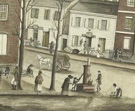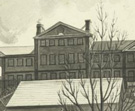|
Humanities and Social Sciences Library > Collections & Reading Rooms > Print Collection > MOVING UPTOWN Section I (including early views)New York from Long Island. About 1800 William Rollinson (American, b. England, 1762–1842) In 1800, New York was the second largest city in the United States; with a population of over 60,000, it was second only to Philadelphia with 72,000. Within ten years, New York, now home to nearly 100,000, had overtaken Philadelphia, and the city's extraordinary growth prompted a visiting Senator from Massachusetts to admit, "The progress of this city is . . . beyond calculation." In William Rollinson's aquatint, John Wood recorded the city from the
Battery to about Chambers Street as seen across the East River from Long
Island. The horizon is punctuated by ships' masts and steeples. In the
center of the print, starting on the left, a cluster of three towers –Trinity,
First Presbyterian Church, and Federal Hall –is followed by the Middle
Dutch Church with its clock tower; the elegant spire of St. Paul's Chapel
dwarfs the square tower of the North Dutch Church; the next tall spire
is that of the Brick Presbyterian Church; and, on the far right, St. George's
Church appears. Anne-Marguérite-Henriette Rouillé de Marigny,
Anne-Marguérite-Henriette Rouillé de Marigny,
Carl Fredrik Akrel (Swedish, 1779–1868) A Swedish aristocrat, Baron Axel Leonhard Klinckowström spent three
years in the United States (1818–20) as an official emissary of his
country; etchings made after his travel sketches and his published letters
capture the spirit and look of the prospering city. City Hall is the centerpiece
of this view of Broadway, facing north from Ann Street. Although in 1819
the cupola was surmounted, as it is today, by Justice with sword and scales,
Klinckowström curiously records a cross. On the far left we glimpse
a fluted column of Saint Paul's Chapel; two doors to the north, at 223
Broadway, is the home of John Jacob Astor. This print also records pigs
rooting along Broadway, a situation which Klinckowström had protested
was a health hazard; he had even seen well-dressed ladies bowled over by
free-running pigs. Jules Louis Frédéric Villeneuve (French, 1796–1842) French artist, naturalist, geographer, engineer, and scholar, Jacques-Gérard
Milbert used New York as the home base for his eight-year sojourn (1815–23)
in the United States. Milbert found the architecture of New York undistinguished,
but the vitality of the city exciting. Like the Baroness Hyde de Neuville,
he selected this middle-class neighborhood as typical of New York. John Hill (American, b. England, 1770–1850) With this view and a companion piece, New York from Weehawk, William Guy Wall created two of the most beautiful early 19th-century views of New York. As in William Rollinson's aquatint after John Wood's turn-of-the-century panorama, New York is seen from across the East River, here from Bergen Hill in Brooklyn (near the present Carroll Park) overlooking the windmill near the Anchor Gin Distillery of Hezekiah Beers Pierrepont at the foot of Joralemon Street. The population had grown since Wood's view. The 1820 census recorded 123,706 people living in Manhattan, and the city was built up beyond City Hall; by the end of the decade it had reached Canal Street. Downtown streets east of Broadway, residential at the end of the Revolution, were now burgeoning with countinghouses and warehouses, serving the demands of shipping and trade. On January 1, 1824, some 324 vessels were berthed in New York harbor. |

